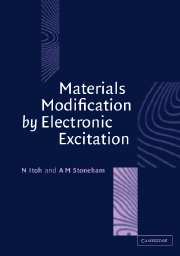Book contents
- Frontmatter
- Contents
- Preface
- 1 Concepts: Excitation, polarons and electronic structure
- 2 Energy deposition and redistribution in solids
- 3 Electron–lattice coupling and its consequences
- 4 Self-trapping
- 5 Local lattice modification by electronic excitation of halides
- 6 Local lattice modification by electronic excitation of crystalline insulating oxides
- 7 Local lattice modification of semiconductors by electronic excitation
- 8 Local lattice modification of amorphous materials by electronic excitation
- 9 Atomic emission and surface modification
- 10 Interface reactions induced by electronic excitation
- 11 High excitation intensities
- 12 Applications of materials modification by excitation
- References
- Index
5 - Local lattice modification by electronic excitation of halides
Published online by Cambridge University Press: 11 August 2009
- Frontmatter
- Contents
- Preface
- 1 Concepts: Excitation, polarons and electronic structure
- 2 Energy deposition and redistribution in solids
- 3 Electron–lattice coupling and its consequences
- 4 Self-trapping
- 5 Local lattice modification by electronic excitation of halides
- 6 Local lattice modification by electronic excitation of crystalline insulating oxides
- 7 Local lattice modification of semiconductors by electronic excitation
- 8 Local lattice modification of amorphous materials by electronic excitation
- 9 Atomic emission and surface modification
- 10 Interface reactions induced by electronic excitation
- 11 High excitation intensities
- 12 Applications of materials modification by excitation
- References
- Index
Summary
In Chapter 4, we discussed the relaxation of excitons and of electron–hole pairs to form self-trapped excitons. In halides, these relaxations may involve asymetrical atomic displacements, including the [Se, Sh] self-trapped exciton. In Chapter 5, we discuss how these asymmetric displacements relate to the asymmetric displacements which lead to defect formation. In the most important case, the displacement creates a pair of neutral defects on the halogen sublattice. This defect pair comprises a halogen atom vacancy (F centre) and a halogen atom interstitial (H centre). The F–H pair is sometimes referred to as a Frenkel pair, but this is misleading, since the term is rightly used for a defect pair comprising a halogen ion vacancy (α centre, X– missing) and a halogen ion interstitial (I centre, Xi– rather than Xi0, differing in charge, site, and symmetry from the H centre).
Almost all of the discussion in this chapter relates to the alkali halides and alkaline-earth fluorides, in which excitons can be self-trapped. The arguments would apply in similar ways to many other halides, but not necessarily to those for which self-trapping does not occur (like the thallous and cuprous halides). Since the self-trapped exciton has a substantial latent energy, only a small energy is needed to transform a self-trapped exciton into an interstitial-vacancy pair on the halogen sublattice. The exciton–phonon coupling which causes exciton self-trapping also assists the creation of defect pairs.
- Type
- Chapter
- Information
- Materials Modification by Electronic Excitation , pp. 187 - 223Publisher: Cambridge University PressPrint publication year: 2000



